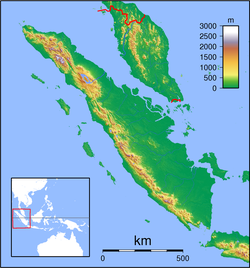2000 Enggano earthquake
| Date | June 4, 2000 |
|---|---|
| Origin time | 16:28:28 UTC |
| Magnitude | 7.9 Mw |
| Depth | 35 km (22 mi) |
| Epicenter | 4°37′S 102°04′E / 4.61°S 102.06°ECoordinates: 4°37′S 102°04′E / 4.61°S 102.06°E |
| Areas affected | Indonesia |
| Max. intensity | VI (Strong) |
| Aftershocks | 6.7 Mw June 4 at 14:39 |
| Casualties | 103 dead 2,174–2,585 injured |
The 2000 Enggano earthquake struck at 23:28 local time on June 4 with a moment magnitude of 7.9 and a maximum Mercalli intensity of VI (Strong). The event occurred off the coast of southern Sumatra, Indonesia near Enggano Island. There were more than 100 fatalities and up to 2,585 injuries. Over 730 aftershocks shocked the area afterwards, one just eleven minutes after the mainshock.
This was the first and southernmost in a series of very large to great Sumatran earthquakes in the 2000s to rupture almost the entire western part of the Sunda megathrust, most notably including the 9.1-9.3 2004 Indian Ocean earthquake, but also the 8.7 2005 Nias–Simeulue earthquake, and the 7.9–8.4 September 2007 Sumatra earthquakes.
Indonesia is well known for strong earthquakes: the 2000 Enggano event marked the beginning of an ongoing period of seismic activity in the area, highlighted by the 2004 Indian Ocean earthquake. The 2000 Enggano earthquake took place at the southeastern end of the fault segment that ruptured during the 1833 Sumatra earthquake. This group of earthquakes, in addition to the 2005 Nias–Simeulue earthquake, all ruptured along the megathrust that forms the interface between the Australian and Sunda Plates. This event was the only one not to cause a tsunami.
Extensive damage and landslides populated the Bengkulu area, with minor injuries and damage on Enggano Island. In the village worst struck, several hundred structures were reported in ruins. Peter Walker of the International Federation of Red Cross and Red Crescent Societies in Geneva denied the earthquake as the major cause of death, instead blaming disease. "...the actual damage from the earthquake isn't that great; the houses are wooden structures so they don't collapse much. But what he found was an endemic problem of rampant malaria, rampant communicable diseases and levels of mortality and morbidity that are totally unacceptable. That is the disaster, not the earthquake." An aftershock measuring 6.2 struck on June 7.
...
Wikipedia

